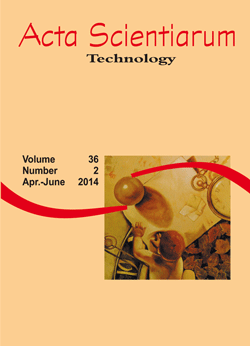<b>Microbial lipase obtained from the fermentation of pumpkin seeds: immobilization potential of hydrophobic matrices<b>
DOI:
https://doi.org/10.4025/actascitechnol.v36i2.18275Palavras-chave:
enzyme, sol-gel, agroindustrial residueResumo
Immobilization potential of lipase from Aspergillus niger on sol-gel matrix was evaluated by physical adsorption and covalent binding and the biochemical characterization of free and immobilized enzyme was performed. Lipase was produced by solid state fermentation of pumpkin seed flour with 30% moisture, at 30°C for 120h. The enzyme was pre-purified with ammonium sulfate and immobilized in the sol-gel matrix by covalent attachment and physical adsorption. A higher yield of immobilization (81.88%) was obtained in the latter. The free enzyme presented higher hydrolytic activity with pH 4.0, at 37°C; moreover, it was more stable with pH between 6.0 and 7.0, at 35°C. The immobilized lipase showed maximum hydrolytic activity with pH 11.0, at 50°C; it was more stable with pH 11.0, at 37°C. Parameters Km and Vmax were best determined by Hanes-Woolf linearization.
Â
Downloads
Downloads
Publicado
Como Citar
Edição
Seção
Licença
DECLARAÇíO DE ORIGINALIDADE E DIREITOS AUTORAIS
Declaro que o presente artigo é original, não tendo sido submetido í publicação em qualquer outro periódico nacional ou internacional, quer seja em parte ou em sua totalidade.
Os direitos autorais pertencem exclusivamente aos autores. Os direitos de licenciamento utilizados pelo periódico é a licença Creative Commons Attribution 4.0 (CC BY 4.0): são permitidos o compartilhamento (cópia e distribuição do material em qualqer meio ou formato) e adaptação (remix, transformação e criação de material a partir do conteúdo assim licenciado para quaisquer fins, inclusive comerciais.
Recomenda-se a leitura desse link para maiores informações sobre o tema: fornecimento de créditos e referências de forma correta, entre outros detalhes cruciais para uso adequado do material licenciado.



















